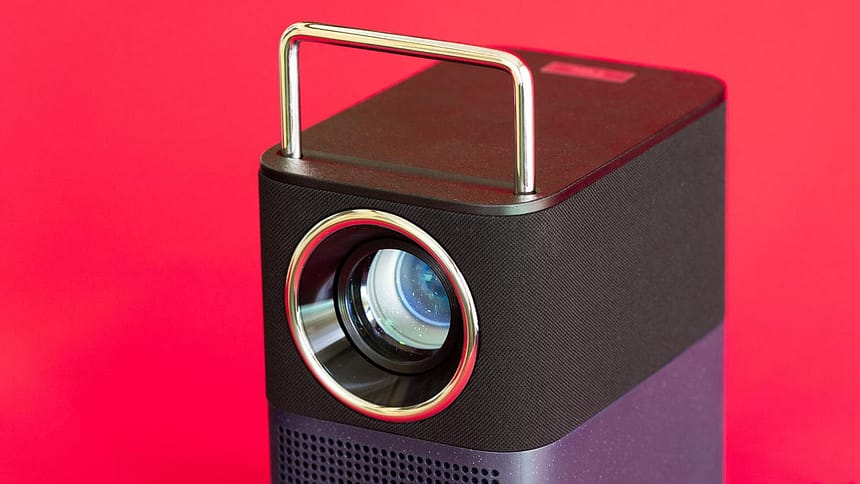
Pros
- Great speakers
- Clever handle/stand design
- Relatively bright
Cons
- Lack of upward throw means you need to use digital keystone
- Is it… staring at me?
Mainstream TV companies occasionally dabble in the projector market, and while Sony has had good results with its high-end models, other brands can have limited success. TCL, a company best known for its big TVs, also manufactures a little projector, the A1, and it’s… a bit odd. It does a few things differently than most projectors and, while I’m all for trying new things, in this case the results are decidedly mixed.
Keeping in mind the list price is only $500 (and it’s currently down to $400 at Amazon), its performance is pretty mild. Certain aspects of its image are decent, while others are not. Perhaps oddest of all is the lack of an upward throw, which I’ll explain more about below, but basically it means you’re required to use keystone correction. That’s something I typically recommend avoiding as it leads to poorer image quality. Meanwhile, it also packs in Google TV streaming, a clever handle/stand design, and an overall fairly attractive look. But these only partially make up for its shortcomings.
Specs and such
- Resolution: 1,920×1,080 pixels
- HDR-compatible: Yes
- 4K-compatible: Yes
- 3D-compatible: No
- Lumens spec: 360
- Zoom: No
- Lens shift: No
- Lamp life (Normal mode): Not listed, but it’s LEDs, so a while
It’s always great to see 1080p present in a lower-cost projector like this one. The 360 lumen rating is a little low for a projector of its size and price, but surprisingly it’s actually less than I measured. I can’t remember the last time that happened. I got roughly 433 lumens, which is still not a lot but decent for a budget projector and brighter than the Anker Mars 3 Air (252 lumens). Its contrast ratio of 2,522:1 was exceptional, likely due to the projector’s simple lens, and is the highest I’ve measured in a sub-$1,000 model. However, brightness uniformity (how evenly bright it is across the entire image) was quite poor.
One aspect you might not pick up from photos is that the carrying handle continues through the body of the projector. Push it down and it becomes the stand to prop up the front of the projector. It’s a clever design, but it does compound a different problem.
There’s no lens shift or zoom, though that’s not unusual for this class of PJ. What is unusual is its lack of upward throw. Nearly every projector projects its image upwards from its lens. Typically this results in the bottom of the image on the screen/wall at or slightly above the height of the projector. This allows placement on a coffee table, say, with the image at a reasonable height. Or, flipping it (literally), mounting the projector close to the ceiling while projecting the image down toward the middle of a wall.
The A1’s lack of upward throw means it needs to be positioned basically dead center to a screen. Only the ultracheap Vimgo P10 was like this in any projector without lens shift I’ve reviewed in recent memory. That projector, interestingly, shared several design aspects with the A1, not least its all-seeing-eye-in-a-tower design.
TCL’s decision to have its A1 work this way essentially means you need to deal with a trapezoidal image, or always use keystone correction, since placing the A1 on the floor requires you to angle the front up to project onto a wall. That is, unless you want to watch half the image on your carpet. Keystone correction reduces resolution and we typically recommend avoiding it, something difficult to do in this case. Is this a dealbreaker for an inexpensive projector not intended for image perfection? I guess not. It’s just… odd.
Connections
- HDMI inputs: 1
- USB port: 1
- Audio: Headphone output, Bluetooth input
- Internet: Wi-Fi
- Remote: Not backlit
Inside is Google TV, so you have access to just about any streaming service you want. All the regulars are here, like Netflix, Disney Plus, Amazon Prime and so on. A single HDMI input lets you connect a game console.
Two 8-watt speaker drivers are packed inside the A1. These sound surprisingly good. There’s far more bass, and the treble is smoother and easier to listen to than most projectors, even those far larger. The sound even plays quite loud, though at higher volumes it breaks up a bit and the bass decreases, but that’s fairly typical for devices like this. You could absolutely use it as a slightly large portable speaker. If you want more, there’s a 3.5mm headphone jack so you can connect to something analog.
Picture quality comparisons
The Anker Nebula Mars 3 Air is one of my favorite portable projectors. It’s a little smaller than the A1, and a little more expensive, but quite capable. The Epson EF21 seems like it’s aimed for a similar place in the market, with a small size and built-in streaming. Yet, the Epson’s list price is way too high at $900, though it’s regularly $650, which is far more reasonable for what you get. I connected each of them to a Monoprice 1×4 distribution amplifier and viewed them side-by-side on a 102-inch, 1.0-gain screen.
The Epson is brighter than the other two projectors, even in its most accurate mode. Put it in its Dynamic mode and you take a slight image quality hit, but then it’s way brighter. However, its contrast ratio is quite poor, so the darkest parts of its image are brighter than the darkest parts of the TCL’s and Anker’s images. It looks flat compared to them as well. The black bars in letterboxed movies are extremely bright gray. The TCL looks by far the most contrasty. Normally, this would be a slam-dunk in a head-to-head competition, but other aspects of the image let it down.
Color is perhaps where they all look the most different. The Epson looks quite natural, creating a far more pleasing and more accurate image. This is why, as I mentioned in its review, it looks better than its numbers suggest. The Anker is OK color-wise. Nothing looks overtly weird, but it lacks the Epson’s accuracy.
The TCL is not great. Its colors, side-by-side here, are less vibrant than the others. Reds and greens especially are noticeably undersaturated. For instance, during the flashing colors of the “Welcome to Sakaar” scene in Thor: Ragnarok, the TCL’s reds were more pink than the others. Is it off by enough that you’d watch it and think “is something wrong?” No, but it makes for a far less impressive image. Color in general isn’t as important as, say, brightness and contrast ratio, but done right, as evidenced by the Epson, it can help a lot.
While the Anker’s contrast is better than the Epson, it also crushes shadow detail, which actually makes its image look more artificial. It’s like editing a photo so the bags under someone’s eyes are even more noticeable. TCL’s impressive contrast ratio is doing all the heavy lifting here. The lack of brightness uniformity results in an odd-looking image, however. Corners of the image are much darker than the center, so it’s almost like watching everything through a vignette filter.
So despite its far worse contrast ratio, the Epson ends up being the most watchable of the three. However, and there’s a big caveat here, before you click over to that review keep in mind I’m judging these three based on the idea that you can get the Epson for $650, its price as of this writing. Were the Epson the original $900, which is wildly high for its performance, the TCL would be the easy pick. Even so, a $150-$250 gap isn’t nothing, and the TCL’s better speakers are a solid “value add.”
Is it… looking at me?
On one hand, I like this new(-ish) breed of inexpensive-but-capable projectors. Google TV has been a real game-changer in the category. I like the idea of a little device you can pull off a shelf and have an impromptu movie night with a single cable and minimal fuss. While you can get far greater performance, which for projectors means a bigger, brighter, better-looking image, for just a bit more money, everything is “a bit more money” now, so why not save a little to get a cozy distraction?
With that in mind, I’m still not entirely sold on the A1. It’s a bit… weird. I’m not against weird. I’m weird. The handle/stand is a smart design. The speakers are excellent for a projector. The size is right. The image’s colors are not right, but I’ve seen worse. Its brightness is fine and its contrast is fantastic. For me, though, I’d just find it hard to live with. I hate keystone correction since it means you’re losing resolution.
For people who don’t care about that, or are just planning on using this for casual (or kids’) viewing, it’s larger than the Epson or the Anker, and those are also $100 to $250 more expensive. So, the A1 is generally quite good given its price and intended use. It’s better than the Samsung Freestyle, I’ll give it that.





